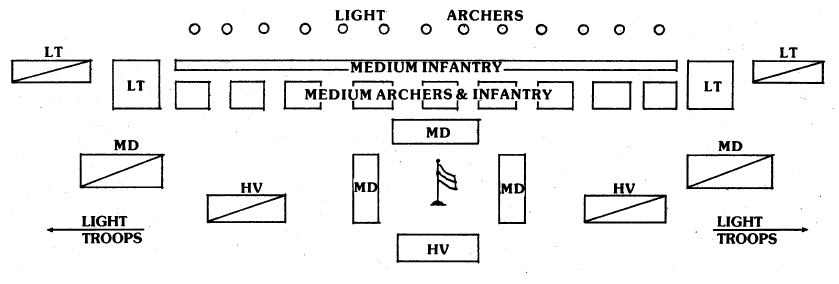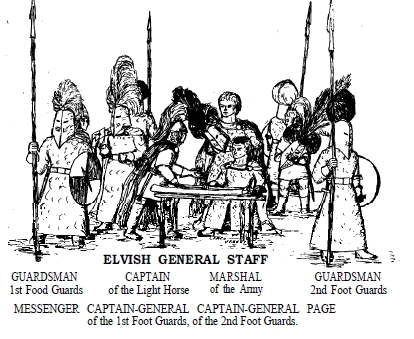
| The Dragon | Races | - | - | The Dragon 28 |
| Tactics | Cavalry | Arms | Armor | Elven Fury |
| Elvish Kindreds | - | Painting Guides | - | Gaming Elves |
Before a discussion of tactics, it is a good idea to go a step back
and
study those aspects of Elvish physiology and society that cause these
tactics. Elves, compared to men, are a little smaller, lighter of build
and
longer-legged. Because of this the elven people tend to be fast moving,
lightly armoured, striking troops. The well known Elvish ability with
a
bow makes this weapon a major element in Elven tactics. This weapon
furthers the striking capacity of the elven troops. Disregarding the
Elven
fury for a moment, Elves do not tend to be blood thirsty individuals,
not
looking to maim and butcher their enemies, but to harass and demoralize
them. All these affect basic elvish tactics, creating a system common
to most Elven peoples.
Tactics
Elven tactics center around the use of light, fast, small, well trained
units. These units would be armed with bows and be used to harass
enemy formations, especially on the march. Elvish light cavalry acts
much like cossacks. These bow units would be grouped with spear and
shield troops, both in the mounted and unmounted cases. Because of
their faster speeds, elves will try to put the enemy at a disadvantage
when choosing a battlefield, the elves usually picking one that favors
their smaller formations. Elves would fight in woods only if they feel
they
need the advantages gained there, for they don’t want to give the enemy
a chance to despoil the forest. When fighting on the battlefield the
elves
employ their medium troops, armed with spears and long swords.
These troops would fight in shallow formations, 4 or 5 ranks, but with
large reserves which can move quickly to relive a dangerous weak spot.
The light troops would be on the flanks trying to harass and outflank
the
enemy. The main reserve would be of heavy elvish infantry, armed with
very long spears. Sometimes medium armoured archers would be
employed in the lines.
Cavalry
The deployment and use of medium and heavy cavalry is complicated
by elvish nature and habits. In Tolkien, there is a reference to
Gandalf riding “elven style” on Shadowfax. Elven style means riding
without saddle or bridle. It is safe to assume elves do not lose any
speed
or mobility for this, since they are better riders than humans are,
and can
talk to the horses as well, thus light cavalry would not suffer. But
heavy
and medium cavalry are shock units, and they rely upon a good seat,
especially when charging with lances. Thus elves, riding stirrupless,
would be at a disadvantage. There are two ways to deal with the
problem. One is to assume that elves will use saddles, stirrups and
bridles in battle meaning they would have heavy and medium cavalry.
The other is to view heavy and medium cavalry as mounted infantry,
able to move into position fast and then dismount to fight. I find
the
second more likely for it is doubtful that an elf would actually endanger
the life of his horse in a charge. In short, the type of troops are:
Light archers — fast moving harassing troops
Light infantry — protect light archers
Light horse archers — harassing troops
Light cavalry — harassing troops
Medium infantry — main line battle troops
Medium archers — often second rank in battle line
Heavy infantry — reserve, made up of elite troops
Medium mounted infantry — fast deployment battle troops
Heavy mounted infantry — fast deployment reserves
Medium cavalry — shock troops
Heavy cavalry — elites, elvish knights
Arms
There are three types of weapons used by elvish armies; the bow,
the spear and the sword. The size of these weapons vary with the troop
types. Light archers use the full-sized elven bow, and carry a rapier-sized
sword. Light infantry carry an eight foot spear, and a slightly heavier
sword. Horse archers carry a horse bow and sword. Light cavalry carry
an eight foot spear and sword. Medium infantry carry a ten foot spear
and long sword. Medium archers use the elven bow and long swords.
Heavy infantry use a twelve foot spear and a hand and a half sword.
Medium mounted infantry would have a long sword and might carry an
eight foot spear. Heavy mounted infantry carry the hand and a half
sword and short spear. The medium and heavy cavalry carry lances and
sword appropriate to their type.

Armour
The light troops usually are unarmoured or wear short leather
jerkens, about 50-50, and carry shields when appropriate. The medium
infantry and cavalry wear short chain shirts and carry medium shields,
the archers carry shields, too. The heavy troops wear long chain byreans
and tall helms, with large shields. No elvish troops wear leg armour.
Elven Fury
All these tactics are the normal way elves fight, but elven fury
changes this. When elves fight they do so with a quiet calm and
somewhat detached manner, which only serves to annoy their enemy
who usually have to whoop and holler to get their nerve up. But when
elves are truly angered they are a horrifying sight to see. Their eyes
begin
to glow with power and their faces become hell to behold. They begin
to
sing war chants in massive unison. Most ancient enemies realize that
they are in a lot of trouble when they hear those chants.
The change in tactics is based on the aggressiveness caused by the
fury. The medium infantry fight in longer, thicker lines, with heavy
infantry holding the center. The light cavalry hold the flanks, while
the
medium and heavy cavalry are reserved. The light archers skirmish in
front of the battle line, then fall back through when contact is about
to be
made; the horse archers still harass the enemy flanks. The light infantry
are held in reserve, ready to move to any weak point in the line. The
medium and heavy cavalry stand ready to charge through any large gap
in their lines, giving the light infantry a chance to seal it.
Elvish Kindreds
This article so far has treated elves as one kind of people, but elves
are usually viewed differently than this. Here are some changes to
make
to specialize each type:
Low elves: often called wood elves, tend to have more light troops.
They often fight in woods. There is little heavy infantry in their
army,
usually just a few nobles. They would use heavy and medium horse as
mounted infantry rather than cavalry.
Middle elves: called grey elves, are about as the article suggests.
They too would use medium and heavy horse as mounted infantry.
High elves: have fewer medium troops. Instead they use heavy
infantry on the line. These elves would have medium and heavy cavalry.
More of their light troops would wear leather.
Sea elves: those who sail ships, are like high elves except they
have
no cavalry.
Half elves: would be composed much like middle elves, except
their horse would be shock cavalry.
Dark elves, or evil elves: if you want to employ them, use their
horse as shock cavalry.
If you have a special kind of elvish race simply adapt the troop
composition to their nature.
Painting Guides
Some elvish colour to add to your army:
1. Elvish armour should be silver, steel or dark metal, other types
of
metal are rarely used.
2. Elves use silver as an indication of rank, not gold.
3. Elves use tan or brown leather, not black or red.
4. Elvish flesh shades from light to dark going from high elf to low. Sea
elves have a dark complexion.
5. Evil elves can have whatever colour flesh you wish, pale white,
black or brown.
6. High elves cloth colours are rich blue and white,
with some other
colours mixed in.
7. Middle elves colours are green and white, with some tans.
8. Low elves colours are dark green and tan, with some browns.
9. Sea elves colours are sea green and sky blue, with sea blue and sea
spray white (an off-white).
10. Dark elves wear browns and blacks, with some tan.
Gaming Elves
This article is about gaming elves, but here are some additional
points:
1. Do not demoralize elves for having their lines broken. They are
not
concerned with having a unified front.
2. Establish conditions for igniting the elven fury, and determine
morale effects for it.
3. Naturally elves are effected by the presence of natural enemies.
